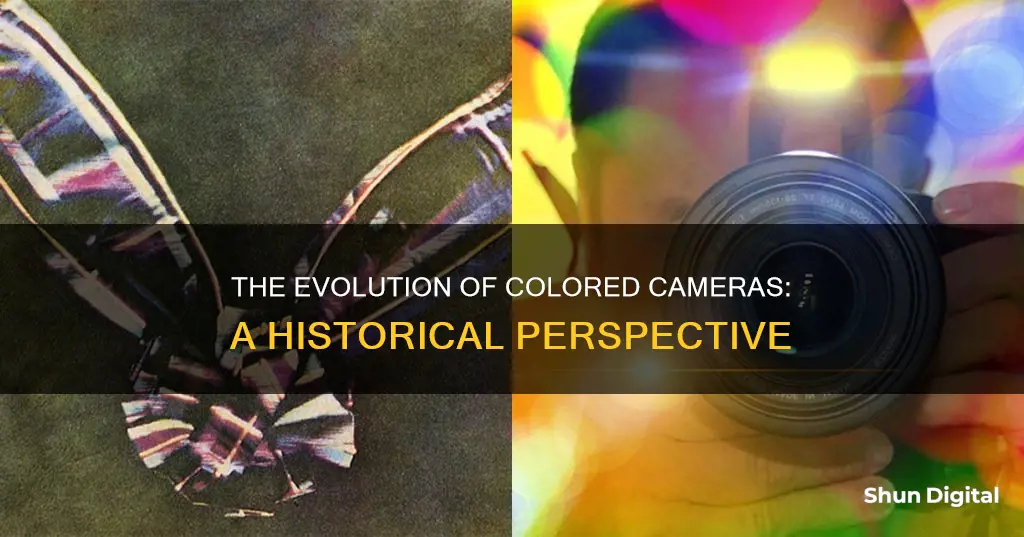
The history of colour photography dates back to the 1840s, but it was only in the 1970s that it became more popular than black-and-white photography. The first colour photograph was produced by Thomas Sutton in 1861, for a lecture by physicist James Clerk Maxwell, who had suggested the three-colour method in 1855. However, colour photography was not common until the 1960s and 1970s, when it became more affordable and reliable for amateur photographers.
| Characteristics | Values |
|---|---|
| First colour photograph | 1861, by Thomas Sutton |
| First colour photograph method invented | 1855, by James Clerk Maxwell |
| First commercially successful colour photograph method | Lumière Autochrome, 1907 |
| First modern "integral tripack" colour film | Kodachrome, 1935 |
What You'll Learn

The first colour photograph was taken in 1861
The Scottish scientist chose to take a picture of a tartan ribbon, created by photographing it three times through red, blue, and yellow filters, then recombining the images into one colour composite.
Maxwell's many other accomplishments tend to overshadow his colour photography (and his poetry!). Nonetheless, the polymath thinker ushered in a revolution in photographic reproduction.
It wasn't until the early 20th century, with the development of colour processes by Gabriel Lippmann and the Sanger Shepherd company, that colour photography came into its own.
The everyday home photographer likely didn't switch to colour photography until the 1960s to 1970s. There were two main reasons for this: colour photographs didn't reliably turn out well in indoor lighting early on, and the more complex colour film was more expensive.
The Magic Behind Polaroid Cameras Charging
You may want to see also

The first colour film was released in 1935
The foundation of all practical colour processes, the three-colour method, was first suggested in 1855 by Scottish physicist James Clerk Maxwell. In 1861, Maxwell and photographer Thomas Sutton produced the first colour photograph using this method. They captured the same image three times through red, green, and blue filters, and assembled a final full-colour composite.
Despite these early developments, colour photography remained impractical for everyday use until the 1960s and 1970s due to challenges with indoor lighting and the higher cost of complex colour film.
In the 1930s, the first practical subtractive colour processes were introduced, marking a shift from additive to subtractive colour film technology. Subtractive colour processes used black-and-white film to capture multiple colour-filtered images, producing a multicoloured print that didn't require special projection equipment.
In 1935, Eastman Kodak introduced the first modern "integral tripack" colour film, named Kodachrome. This film had three layers of emulsion coated on a single base, each layer capturing one of the three additive primary colours: red, green, and blue. This film was initially available for home movies, but Kodak soon offered it for still photography as well.
In the following years, Kodak continued to innovate with colour film, releasing Kodacolor in 1942, which was designed to produce colour negatives for making prints. By the 1970s, colour photography had become the dominant form, with monochrome photography largely relegated to niche markets.
Are Camera Batteries Charged? Understanding Camera Battery Basics
You may want to see also

Colour photography was popularized in the 1960s-1970s
The 1960s and 1970s saw a significant shift in the popularity of colour photography, which had been available since the 1930s but was yet to be widely accepted as a legitimate art form.
In the 1960s and 1970s, colour photography was embraced by a younger generation of artists, who were less concerned with the institutional recognition that their older peers sought. Instead, they were drawn to the new frontier of colour, which offered a way to experiment and frame the world differently. This shift was not due to technological advances, as colour processes had been introduced as early as 1907 with the Lumière Autochrome, and Kodak's Kodachrome had been released in 1936.
The popularisation of colour photography in this period was driven by artists such as William Eggleston, who is widely regarded as the most important figure in colour photography. Eggleston's use of colour transformed the seemingly mundane into enchanting, tinted snapshots of modernising suburban life in the Deep South. Eggleston's work inspired and influenced other photographers, including Stephen Shore, whose work captured the zeitgeist of 1970s America, and Joel Meyrowitz, whose portraits of Cape Cod were published in the influential 1979 photobook, "Cape Light".
Other notable photographers who contributed to the popularisation of colour photography in this period include Harry Callahan, Helen Levitt, Barbara Kasten, Jan Groover, Joel Meyerowitz, John Divola, Joel Sternfeld, and Richard Misrach.
Extend Camera Battery Life: Tips for Photographers
You may want to see also

Colour film was expensive and technically challenging
The development of colour film was a long and challenging process. The first colour photograph was produced by Thomas Sutton in 1861, based on the three-colour method proposed by Scottish physicist James Clerk Maxwell in 1855. However, colour photography remained impractical for several decades due to technical limitations and the high cost of producing colour film.
Early experiments in colour photography involved finding a "chameleon substance" that would assume the colour of the light falling on it. While some encouraging results were obtained, these methods often required extremely long exposure times, ranging from hours to days. Another challenge was the quick fading of colours when the images were exposed to light for viewing.
In the late 19th century, various inventors and companies developed colour photography processes, such as the Joly screen process and the Kromskop system. However, these methods had limitations, such as visible coloured lines on the final image or the need for specialised viewing equipment.
The first commercially successful colour process was the Lumière Autochrome, introduced in 1907. However, it had drawbacks such as long exposure times and high cost compared to black-and-white film.
The development of colour film continued in the following decades, with companies like Kodak and Agfa introducing new products. The first modern "integral tripack" colour film, Kodachrome, was introduced in 1935. This film had three layers of different colour-sensitive emulsions coated on a single base. However, colour film remained expensive and less versatile than black-and-white film for several decades.
It wasn't until the 1960s and 1970s that colour photography became widely adopted by amateur home photographers. The improvement in colour film technology and the decreasing cost made it more accessible to the general public.
Explore Lorex Camera Corridor Mode: Maximizing Your Camera's View
You may want to see also

Colour photography was pioneered by James Clerk Maxwell
Colour photography was pioneered by Scottish mathematical physicist James Clerk Maxwell in 1861. Maxwell is credited as the founder of the theory of additive colour.
Maxwell's work on colour photography was based on his studies of colour vision. He demonstrated that any visible hue or grey tone could be created by mixing only three pure colours of light: red, green, and blue. He also drew an analogy to black-and-white photography, suggesting that if three colourless photographs of the same scene were taken through red, green, and blue filters, and then projected through the same filters and superimposed on a screen, the result would be an image reproducing all the colours in the original scene.
In 1861, Maxwell presented the world's first demonstration of colour photography. Working with photographer Thomas Sutton, Maxwell had a tartan ribbon photographed three times, through red, green, and blue filters. The three photographs were then projected onto a screen with three different projectors, each equipped with the same colour filter used to photograph it. When superimposed on the screen, the three images formed a full-colour image.
The original three photograph plates used for this demonstration now reside in a small museum at 14 India Street, Edinburgh, the house where Maxwell was born.
Unleashing Camera Raw: A Guide to Unlocking the Power
You may want to see also







